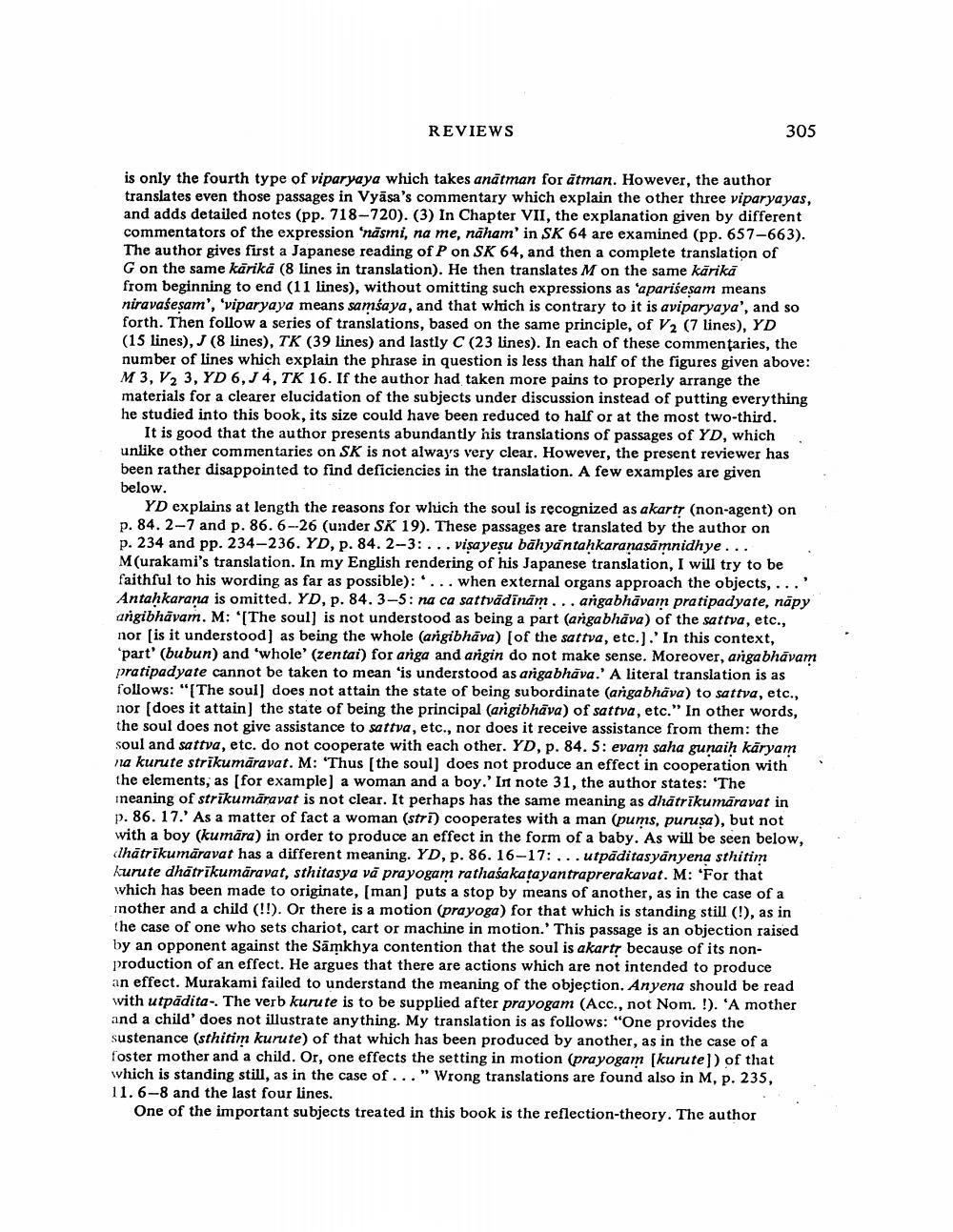________________
REVIEWS
305
is only the fourth type of viparyaya which takes anātman for atman. However, the author translates even those passages in Vyāsa's commentary which explain the other three viparyayas, and adds detailed notes (pp. 718-720). (3) In Chapter VII, the explanation given by different commentators of the expression 'nāsmi, na me, naham' in SK 64 are examined (pp. 657-663). The author gives first a Japanese reading of P on SK 64, and then a complete translation of G on the same karika (8 lines in translation). He then translates M on the same karika from beginning to end (11 lines), without omitting such expressions as 'apariśesam means niravaśesam', 'viparyaya means samsaya, and that which is contrary to it is aviparyaya', and so forth. Then follow a series of translations, based on the same principle, of V2 (7 lines), YD (15 lines), J (8 lines), TK (39 lines) and lastly C (23 lines). In each of these commentaries, the number of lines which explain the phrase in question is less than half of the figures given above: M3, V23, YD 6, J 4, TK 16. If the author had taken more pains to properly arrange the materials for a clearer elucidation of the subjects under discussion instead of putting everything he studied into this book, its size could have been reduced to half or at the most two-third.
It is good that the author presents abundantly his translations of passages of YD, which unlike other commentaries on SK is not always very clear. However, the present reviewer has been rather disappointed to find deficiencies in the translation. A few examples are given below.
YD explains at length the reasons for which the soul is recognized as akarty (non-agent) on p. 84.2-7 and p. 86.6--26 (under SK 19). These passages are translated by the author on p. 234 and pp. 234-236. YD, p. 84. 2-3: ... visayesu bahyantahkaranasamnidhye... . Murakami's translation. In my English rendering of his Japanese translation, I will try to be faithful to his wording as far as possible): ... when external organs approach the objects, ...' Antahkarana is omitted. YD, p. 84.3-5: na ca sattvādinām ... angabhāvam pratipadyate, näpy angibhāvam. M: "[The soul] is not understood as being a part (angabhāva) of the sattva, etc., nor is it understood) as being the whole (arigibhava) (of the sattva, etc.).' In this context,
part' (bubun) and 'whole' (zentai) for ariga and angin do not make sense. Moreover, arga bhāvam pratipadyate cannot be taken to mean 'is understood as arigabhāva.' A literal translation is as follows: "[The soul) does not attain the state of being subordinate (angabhava) to sattva, etc., nor (does it attain) the state of being the principal (arigibhāva) of sattva, etc." In other words, the soul does not give assistance to sattva, etc., nor does it receive assistance from them: the soul and sattva, etc. do not cooperate with each other. YD, p. 84.5: evam saha gunaih kāryam na kurute strikumäravat. M: 'Thus (the soul) does not produce an effect in cooperation with the elements, as (for example) a woman and a boy.' In note 31, the author states: "The ineaning of strikumāravat is not clear. It perhaps has the same meaning as dhätrikumāravat in p. 86. 17. As a matter of fact a woman (strī) cooperates with a man (pums, purusa), but not with a boy (kumāra) in order to produce an effect in the form of a baby. As will be seen below, (lhätrikumäravat has a different meaning. YD, p. 86. 16-17: ... utpăditasyanyena sthitim kurute dhätrikumāravat, sthitasya vā prayogam rathasakatayantraprerakavat. M: 'For that which has been made to originate, (man) puts a stop by means of another, as in the case of a inother and a child (!!). Or there is a motion (prayoga) for that which is standing still (!), as in the case of one who sets chariot, cart or machine in motion. This passage is an objection raised by an opponent against the Samkhya contention that the soul is akarty because of its nonproduction of an effect. He argues that there are actions which are not intended to produce an effect. Murakami failed to understand the meaning of the objection. Anyena should be read with utpädita. The verb kurute is to be supplied after prayogam (Acc., not Nom. !). A mother and a child' does not illustrate anything. My translation is as follows: "One provides the sustenance (sthitim kurute) of that which has been produced by another, as in the case of a foster mother and a child. Or, one effects the setting in motion (prayogam (kurutel) of that which is standing still, as in the case of ..." Wrong translations are found also in M, p. 235, 11. 6-8 and the last four lines.
One of the important subjects treated in this book is the reflection-theory. The author




